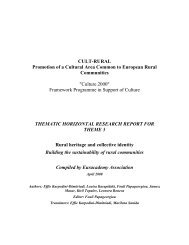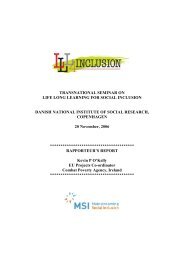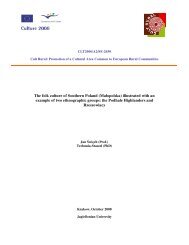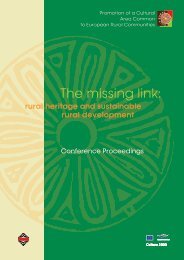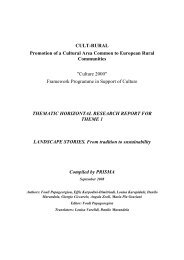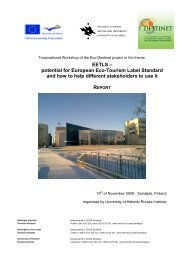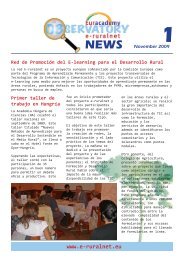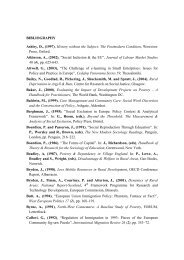ÐÐ¾Ð´Ð°Ñ Ð¿Ð¾ изложбаÑа - cult rural - Prisma
ÐÐ¾Ð´Ð°Ñ Ð¿Ð¾ изложбаÑа - cult rural - Prisma
ÐÐ¾Ð´Ð°Ñ Ð¿Ð¾ изложбаÑа - cult rural - Prisma
Create successful ePaper yourself
Turn your PDF publications into a flip-book with our unique Google optimized e-Paper software.
SYMBOLISMS OF FERTILITY AND REBIRTH<br />
OF NATURE<br />
a symbolic contribution for fi eld animals, which has an older genesis (a gift for<br />
the world of spirits). The dożynki rites in manors were much more spectacular.<br />
For this occasion a special dożynki wreath was made, which was brought to<br />
church in a solemn procession of men and women in smart clothes, musicians<br />
and harvesters. After the blessing it was given as a gift by the best harvesters<br />
to the squire. The rite was accompanied by dożynki songs recounting the hard<br />
work, expressing wishes of good luck for the host and encouraging him to treat<br />
the harvesters. The squire, the owner of the fi elds, paid the harvesters their<br />
remuneration; next the party began which lasted until late at night. The dożynki<br />
rites along with all other basic rites are still practised. The role of hosts has been<br />
taken by self-government representatives of various levels, and the dożynki rite<br />
has assumed the form of a folk festival. A characteristic element of dożynki is<br />
still the wreaths made of different kinds of cereal, decorated with ribbons, herbs,<br />
fruit and fl owers. The tradition requires that the grains from the wreath should<br />
be added to spring sowing in order to secure a good harvest. The traditional<br />
wreaths most often had a shape of a crown or a hemisphere. The modern form of<br />
a wreath depends on its creators’ ingeniousness. However, it is always set in the<br />
Polish folk and religious tradition.<br />
harvest women start singing and dancing around the brada. The best of the<br />
harvesters ritually washes her hands and cuts the spikes in one cut; then she<br />
weaves them in a pleat (brada). The decorated brada is solemnly carried to the<br />
village and is left in the granary where it is kept until next year. This imitative<br />
magical act is meant to secure a future good harvest. Similar to that are the<br />
preparatory sowing practices in autumn. The largest seeds are chosen and mixed<br />
with tiny pebbles for the wheat to grow large. The sower puts something red in<br />
the measure vessel – a red pepper, a bunch of flowers or fibrils of red yarn and<br />
even a comb – so that the wheat becomes ripe (associated with red) and thick as<br />
the comb teeth.<br />
In Bulgaria, the last of the spring-summer prosperity-bringing customs is related<br />
to the end of harvest. Then the so-called brada (beard) is made from the largest<br />
full-eared wheat spikes, especially left uncut by the reapers. The spikes are tied<br />
with a red thread and the ground around them is dug with the point of the sickle,<br />
then it is watered and “fed” with pieces of bread in the four cardinal points. The<br />
30<br />
56. 57.<br />
56. Toys from straw spikes, Bulgaria<br />
57. During the harvest rites, Greek farmers offer<br />
fruit to the church<br />
58. „Dożynki” wreath from Wielkie Oczy,<br />
Podkarpackie voivodship, phot. T. Lorenc, 2007,<br />
Poland<br />
59. Hand-made basket fi lled with sweets and<br />
fruit and decorative earcorns celebrating harvest<br />
in Greece<br />
60. Harvest wreath, near Lubaczow,<br />
Podkarpackie voivodship, 2006, Poland




